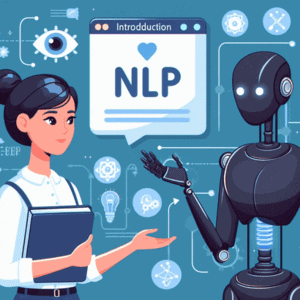Introduction of Neuro Linguistic Programming
NLP is a captivating and highly effective methodology that delves into the intricate workings of human behavior, offering profound insights and strategies for personal growth and interpersonal communication. Originating in the 1970s, NLP emerged from the collaboration between Richard Bandler and John Grinder, who integrated principles from cognitive and behavioral psychology with linguistics and neurology. This synthesis aimed to decode the patterns of excellence exhibited by exceptional individuals in various fields, from therapy to business and beyond.
At its core, NLP explores how our neurology (neuro), language (linguistic), and patterns of behavior (programming) shape our experiences and interactions with the world. By understanding and utilizing these patterns, individuals can gain greater control over their thoughts, emotions, and actions, thereby fostering personal transformation and achieving desired outcomes.
The principles of NLP are grounded in the belief that our subjective experiences are shaped by the unique filters through which we perceive and interpret reality. Techniques such as modeling excellence, reframing perspectives, and anchoring positive states are integral to NLP practices. These methods empower individuals to overcome limiting beliefs, enhance communication effectiveness, and cultivate deeper connections with others.
Practically, NLP finds application across diverse fields. In therapy, practitioners use NLP techniques to help clients overcome phobias, manage stress, and improve self-confidence. NLP is a science related to human brain and mind. In business and leadership, NLP is utilized to enhance communication skills, negotiate effectively, and lead teams with clarity and influence. Moreover, educators employ NLP to optimize learning environments and facilitate accelerated learning techniques.
As we explore the origins, principles, and practical applications of NLP, we uncover a versatile toolkit that not only empowers personal growth but also fosters meaningful changes in how individuals perceive and engage with their environments. Whether you’re seeking to enhance your own development journey or improve your professional capabilities, NLP offers a pathway to unlock your fullest potential and achieve lasting success.
Origins and Key Contributors
NLP was co-created by Richard Bandler and John Grinder in the early 1970s at the University of California, Santa Cruz. They sought to identify patterns in the language and behavior of successful therapists, including Milton H. Erickson, Virginia Satir, and Fritz Perls, and to develop techniques that could be used to replicate their success. Bandler, a student of mathematics and computer science, and Grinder, a linguist, combined their expertise to create a framework that explores the relationship between neurological processes (neuro), language (linguistic), and behavioral patterns that have been learned through experience (programming).
Fundamental Principles of NLP
NLP is built on several core principles:
- The Map is Not the Territory: This principle, derived from Alfred Korzybski’s work, suggests that our perception of the world (our map) is not the actual world itself (the territory). NLP emphasizes understanding and changing these perceptions to create more effective ways of thinking and behaving.
- Behavior and Change: NLP posits that all behavior has a structure, which can be modeled, learned, and changed. By identifying successful strategies and replicating them, individuals can achieve desired outcomes more effectively.
- Sensory Acuity and Rapport: Effective communication relies on acute sensory awareness and the ability to establish rapport. NLP techniques help individuals become more aware of non-verbal cues and build strong connections with others.
- Outcome Orientation: NLP encourages a focus on well-defined outcomes rather than problems. By setting clear, achievable goals, individuals can direct their efforts towards positive change.
- Flexibility: Flexibility in thinking and behavior is key to overcoming obstacles and achieving success. NLP promotes adaptability and the willingness to change strategies when needed.
Practical Applications of NLP
NLP has a wide range of applications, from personal development and therapy to business and education. Here are some practical examples:
- Anchoring: This technique involves associating a specific stimulus with a desired emotional state. For instance, a person might anchor a feeling of confidence by pressing their thumb and forefinger together while experiencing a moment of confidence. Later, they can trigger this state by repeating the gesture.
- Reframing: Reframing involves changing the context or meaning of a situation to alter its emotional impact. For example, viewing a challenging task as an opportunity for growth rather than a threat can significantly reduce anxiety.
- Swish Pattern: This visualization technique helps individuals replace negative thought patterns with positive ones. By vividly imagining a negative image being replaced by a positive, empowering image, individuals can change their emotional responses and behaviors.
- Mirroring and Matching: Building rapport through mirroring involves subtly matching the body language, tone, and language of another person. This technique fosters a sense of connection and trust, enhancing communication and influence.
Notable Researchers and Influences
In addition to Bandler and Grinder, several other researchers and practitioners have significantly contributed to the development and dissemination of NLP:
- Milton H. Erickson: A renowned psychiatrist and hypnotherapist, Erickson’s techniques in hypnosis and therapy greatly influenced NLP‘s methods for inducing change and communication.
- Virginia Satir: A pioneering family therapist, Satir’s work on communication and family dynamics provided valuable insights into interpersonal relationships and therapeutic techniques used in NLP.
- Fritz Perls: The founder of Gestalt therapy, Perls’ focus on awareness and experiential learning influenced NLP’s emphasis on sensory awareness and present-moment experience.
Conclusion
NLP offers a powerful toolkit for understanding and transforming human behavior. By exploring the connections between our thoughts, language, and actions, NLP provides practical techniques for achieving personal and professional growth. Whether you’re looking to improve your communication skills, overcome limiting beliefs, or achieve specific goals, NLP offers valuable insights and strategies for creating lasting change.



Hey people!!!!!
Good mood and good luck to everyone!!!!!
Hello to every body, it’s my first go to see of this website;
this website contains awesome and really excellent data designed for readers.
Excellent items from you, man. I have take into accout your stuff previous
to and you’re just too magnificent. I actually like what you have acquired
right here, certainly like what you’re saying and the
best way in which you assert it. You are making it entertaining and
you continue to take care of to keep it sensible.
I can not wait to learn far more from you. This is actually a great web site.
Thank You So Much…